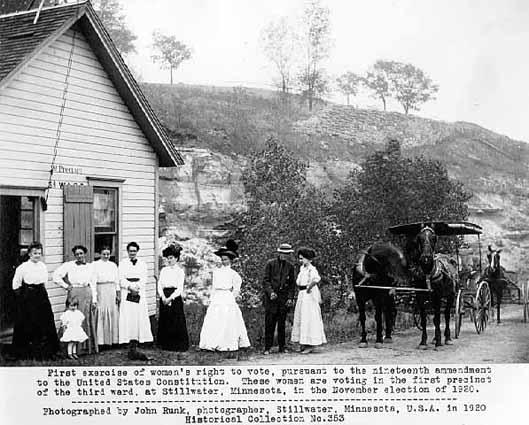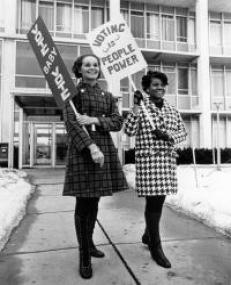
LWV ABC History | LWVMN History | LWVUS History | Suffrage Timeline
Anoka County League History
 Women in our area were among the early activists in the women's suffrage movement. In 1869, Mary Jackman Colburn of Champlin formed one of the two first local suffagist societies in Minnesota. In 1883, once the statewide Minnesota Woman Suffrage Association (MWSA) was formed, Champlin and Anoka were among the first nine affiliated committeess for suffrage. After the founding of the League of Women Voters, women in our area were active in a number of city based local leagues - Anoka, Blaine, Circle Pines, Columbia Heights, Coon Rapids and Fridley each had a League of Women Voters local league.
Women in our area were among the early activists in the women's suffrage movement. In 1869, Mary Jackman Colburn of Champlin formed one of the two first local suffagist societies in Minnesota. In 1883, once the statewide Minnesota Woman Suffrage Association (MWSA) was formed, Champlin and Anoka were among the first nine affiliated committeess for suffrage. After the founding of the League of Women Voters, women in our area were active in a number of city based local leagues - Anoka, Blaine, Circle Pines, Columbia Heights, Coon Rapids and Fridley each had a League of Women Voters local league.
The Anoka League of Women Voters was first organized in April 1920 when the National League of Women Voters chair Maud Wood Parker visited Anoka. Under the leadership of President Mrs. Gus Peterson, the Anoka League of Women Voters conducted a one day political school for women voters at the 1920 Anoka County Fair. Although this local League later disbanded, as many organizations did during the depression, the Anoka League of Women Voters was re-organized at a tea held by Mary Hensler Spurzen on May 18, 1938. Twenty-five women attended the tea to meet with two representatives from the Minnesota League.
In the early 1970's, the Anoka and Coon Rapids Leagues merged to form the Anoka-Coon Rapids League of Women Voters. In 1979, the Blaine League, initially formed in 1966, merged with the Anoka-Coon Rapids League. The following year, the Anoka-Coon Rapids League officially changed its name to the League of Women Voters Anoka, Blaine, Coon Rapids Area (LWV ABC). Fridley LWV disbanded in the early 2000's, Columbia Heights LWV disbanded in the early 1980's and Circle Pines LWV disbanded in 1959, so now LWV ABC serves all of Anoka County, as well as some of northern Hennepin County.
In 1974, the National League of Women Voters welcomed men to full membership and Fred Strobel became the first man to join League in Anoka County.
From the beginning, LWV ABC and its predecessors have been involved in registering voters, informing voters through candidate forums, studying local issues, publishing candidate questionnaires and providing information about the election process.
Over the years LWV ABC has put research into action through projects benefiting local communities. Past projects include:
- Working to establish city wide garbage collection in Anoka
- Obtaining permanent absentee ballot legislation in Minnesota
- Studying the Rice Creek Watershed
- Educating the public about creating a pollinator friendly environment

 In 1890, the National American Woman Suffrage Association (NAWSA) was formed from a merger of the of National Woman Suffrage Association (NWSA) and American Woman Suffrage Association (AWSA). It's sole purpose: securing the right to vote for women.
In 1890, the National American Woman Suffrage Association (NAWSA) was formed from a merger of the of National Woman Suffrage Association (NWSA) and American Woman Suffrage Association (AWSA). It's sole purpose: securing the right to vote for women.